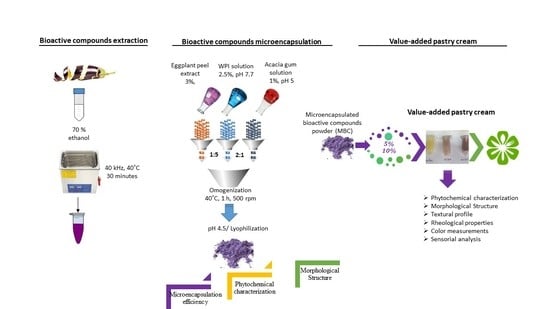Value-Added Pastry Cream Enriched with Microencapsulated Bioactive Compounds from Eggplant (Solanum melongena L.) Peel
Abstract
:1. Introduction
2. Materials and Methods
2.1. Materials
2.2. Phytochemical Extraction and Characterization of Eggplant Peel Extract
2.3. Phytochemical Microencapsulation and Characterization of the Powder
2.4. Efficiency of Anthocyanin Encapsulation
2.5. Preparation of Pastry Cream Supplemented with MBC
2.6. Confocal Laser Scanning Microscopy
2.7. Textural Profile Analysis
2.8. Rheological Properties
2.9. Color Measurements
2.10. Sensory Analysis
2.11. Statistical Analysis
3. Results and Discussion
3.1. Phytochemical Extraction and Characterization of EPE
3.2. Microencapsulation Efficiency and Characterization of the MBC
3.3. Pastry Cream Enriched with MBC
3.4. Morphological Structure of the MBC and Pastry Creams
3.5. Textural Properties of Pastry Cream
3.6. Rheological Characterization of MBC Enriched Creams
3.7. Color Parameters of MBC and Enriched Creams
3.8. Sensorial Analysis of MBC Enriched Creams
4. Conclusions
Author Contributions
Funding
Acknowledgments
Conflicts of Interest
References
- Semwal, S.; Chaudhary, N.; Karoulia, S. Addition of carrot pomace to increase the nutritional and rheological properties of traditional cake. Int. J. Sci. Res. 2016, 5, 1412–1416. [Google Scholar]
- Shabeer, M.; Sultan, M.T.; Abrar, M.; Suffyan Saddique, M.; Imran, M.; Saad Hashmi, M.; Sibt-e-Abbas, M. Utilization of defatted mango kernel in wheat-based cereals products: Nutritional and functional properties. Int. J. Fruit Sci. 2016, 16, 444–460. [Google Scholar] [CrossRef]
- Wani, A.A.; Sogi, D.S.; Singh, P.; Khatkar, B.S. Influence of watermelon seed protein concentrates on dough handling, textural and sensory properties of cookies. J. Food Sci. Technol. 2015, 52, 2139–2147. [Google Scholar] [CrossRef] [Green Version]
- Belghith Fendri, L.; Chaari, F.; Maaloul, M.; Kallel, F.; Abdelkafi, L.; Ellouz Chaabouni, S.; Ghribi-Aydi, D. Wheat bread enrichment by pea and broad bean pods fibers: Effect on dough rheology and bread quality. LWT-Food Sci. Technol. 2016, 73, 584–591. [Google Scholar] [CrossRef]
- Ben Jeddou, K.; Bouaziz, F.; Zouari-Ellouzi, S.; Chaari, F.; Ellouz-Chaabouni, S.; Ellouz-Ghorbel, R.; Nouri-Ellouz, O. Improvement of texture and sensory properties of cakes by addition of potato peel powder with high level of dietary fiber and protein. Food Chem. 2017, 217, 668–677. [Google Scholar] [CrossRef]
- Martins, Z.E.; Pinho, O.; Ferreira, I.M.P.L.V.O. Food industry by-products used as functional ingredients of bakery products. Trends Food Sci. Technol. 2017, 67, 106–128. [Google Scholar] [CrossRef]
- Eswaran, S.; Muir, J.; Chey, W.D. Fiber and functional gastrointestinal disorders. Am. J. Gastroenterol. 2013, 108, 718–727. [Google Scholar] [CrossRef]
- Somawathi, K.M.; Rizliya, V.; Wijesinghe, D.G.N.G.; Madhujith, W.M.T. Antioxidant activity and total phenolic content of different skin coloured brinjal (Solanum melongena). Trop. Agric. Res. 2014, 26, 152–161. [Google Scholar] [CrossRef]
- Djouadi, A.; Lanez, T.; Boubekri, C. Evaluation of antioxidant activity and polyphenolic contents of two South Algerian eggplants cultivars. J. Fundam. Appl. Sci. 2016, 8, 223–231. [Google Scholar] [CrossRef] [Green Version]
- Gallo, M.; Naviglio, D.; Ferrara, L. Nasunin, an antioxidant anthocyanin from eggplant peels, as natural dye to avoid food allergies and intolerances. Eur. Sci. J. 2014, 10, 158–167. [Google Scholar]
- Igarashi, K.; Yoshida, T.; Suzuki, E. Antioxidative activity of nasunin in Chouja-nasu (Little eggplant, Solanum melongena L. ‘Chouja’). Nippon Kogyo Gakkaishi 1993, 40, 138–143. [Google Scholar] [CrossRef]
- Hosseini, S.; Gharachorloo, M.; Ghiassi-Tarzi, B.; Ghavami, M. Evaluation of the organic acids ability for extraction of anthocyanins and phenolic compounds from different sources and their degradation kinetics during cold storage. Pol. J. Food Nutr. Sci. 2016, 66, 261–270. [Google Scholar] [CrossRef]
- Horincar, G.; Enachi, E.; Stănciuc, N.; Râpeanu, G. Extraction and characterization of bioactive compounds from eggplant peel using ultrasound–assisted extraction. Ann. Univ. Dunarea Jos Galati Fascicle VI-Food Technol. 2019, 43, 40–53. [Google Scholar] [CrossRef]
- Nayanathara, A.R.; Mathews, A.; Aalolam, K.P.; Reshma, J.K. Evaluation of total phenol, flavonoid and anthocyanins content in different varieties of eggplant. Emerg. Life Sci. Res. 2016, 2, 63–65. [Google Scholar]
- Dipti, S.S.; Bergman, C.; Indrasari, S.D.; Herath, T.; Hall, R.; Lee, H.; Habibi, F.; Bassinello, P.Z.; Graterol, E.; Ferraz, J.P.; et al. The potential of rice to offer solutions for malnutrition and chronic diseases. Rice 2012, 5, 16. [Google Scholar] [CrossRef] [Green Version]
- Samyor, D.; Das, A.B.; Deka, S.C. Pigmented rice a potential source of bioactive compounds: A review. Int. J. Food Sci. Technol. 2017, 52, 1073–1081. [Google Scholar] [CrossRef]
- De Pascual-Teresa, S.; Sanchez-Ballesta, M.T. Anthocyanins: From plant to health. Phytochem. Rev. 2008, 7, 281–299. [Google Scholar] [CrossRef]
- Ye, Q.; Georges, N.; Selomulya, C. Microencapsulation of active ingredients in functional foods: From research stage to commercial food products. Trends Food Sci. Technol. 2018, 78, 167–179. [Google Scholar] [CrossRef]
- Nontasan, S.; Moongngarm, A.; Deeseenthum, S. Application of functional colourant prepared from black rice bran in yogurt. APCBEE Procedia 2012, 2, 62–67. [Google Scholar] [CrossRef] [Green Version]
- Li, K.; Woo, M.W.; Patel, H.; Selomulya, C. Enhancing the stability of protein-polysaccharides emulsions via Maillard reaction for better oil encapsulation in spray-dried powders by pH adjustment. Food Hydrocoll. 2017, 69, 121–131. [Google Scholar] [CrossRef]
- Sarabandi, K.; Jafari, S.M.; Mahoonak, A.S.; Mohammadi, A. Application of gum Arabic and maltodextrin for encapsulation of eggplant peel extract as a natural antioxidant and color source. Int. J. Biol. Macromol. 2019, 140, 59–68. [Google Scholar] [CrossRef] [PubMed]
- Condurache, N.N.; Aprodu, I.; Crăciunescu, O.; Tatia, R.; Horincar, G.; Barbu, V.; Râpeanu, G.; Bahrim, G.E.; Oancea, A.; Stănciuc, N. Probing the Functionality of Bioactives from Eggplant Peel Extracts Through Extraction and Microencapsulation in Different Polymers and Whey Protein Hydrolysates. Food Bioproc. Technol. 2019, 12, 1316–1329. [Google Scholar] [CrossRef]
- Stănciuc, N.; Turturică, M.; Oancea, A.M.; Barbu, V.; Ioniţă, E.; Aprodu, I.; Râpeanu, G. Microencapsulation of anthocyanins from grape skins by whey protein isolates and different polymers. Food Bioproc. Technol. 2017, 10, 1715–1726. [Google Scholar] [CrossRef]
- Turturică, M.; Stanciuc, N.; Bahrim, G.; Râpeanu, G. Effect of thermal treatment on phenolic compounds from plum (Prunus domestica) extracts—A kinetic study. J. Food Eng. 2016, 171, 200–207. [Google Scholar] [CrossRef]
- Lee, J.; Durst, R.W.; Wrolstad, R.E. Determination of total monomeric anthocyanin pigment content of fruit juices, beverages, natural colourants, and wines by the pH differential method: Collaborative study. J. AOAC Int. 2005, 88, 1269–1278. [Google Scholar] [CrossRef] [PubMed] [Green Version]
- Pai, T.; Sawant, S.Y.; Ghatak, A.A.; Chaturvedi, P.A.; Gupte, A.M.; Desai, N.S. Characterization of Indian beers: Chemical composition and antioxidant potential. J. Food Sci. Technol. Mysore 2015, 52, 414–1423. [Google Scholar] [CrossRef] [PubMed] [Green Version]
- Zhao, H.; Chen, W.; Lu, J.; Zhao, M. Phenolic profiles and antioxidant activities of commercial beers. Food Chem. 2010, 119, 1150–1158. [Google Scholar] [CrossRef]
- Akhavan Mahdavi, S.; Jafari, M.S.; Assadpoor, E.; Dehnad, D. Microencapsulation optimization of natural anthocyanins with maltodextrin, gum Arabic and gelatin. Int. J. Biol. Macromol. 2016, 85, 379–385. [Google Scholar] [CrossRef]
- AOAC. Official Methods of Analysis of the Association of Official Analytical Chemists, 14th ed.; Association of Official Analytical Chemists: Washington, DC, USA, 2005; Volume II. [Google Scholar]
- Aggarwal, D.; Sabikhi, L.; Kumar, M.S. Formulation of reduced-calorie biscuits using artificial sweeteners and fat replacer with dairy–multigrain approach. NFS J. 2016, 2, 1–7. [Google Scholar] [CrossRef] [Green Version]
- Dranca, F.; Oroian, M. Optimization of ultrasound-assisted extraction of total monomeric anthocyanin (TMA) and total phenolic content (TPC) from eggplant (Solanum melongena L.) peel. Ultrason. Sonochem. 2016, 31, 637–646. [Google Scholar] [CrossRef]
- Jung, E.J.; Bae, M.S.; Jo, E.K.; Jo, Y.J.; Lee, S.C. Antioxidant activity of different parts of eggplant. J. Med. Plant Res. 2011, 5, 4610–4615. [Google Scholar]
- Ferarsa, S.; Zhang, W.; Moulai-Mostefa, N.; Ding, L.; Jaffrin, M.Y.; Grimib, N. Recovery of anthocyanins and other phenolic compounds from purple eggplant peels and pulps using ultrasonic-assisted extraction. Food Bioprod. Process 2018, 109, 19–28. [Google Scholar] [CrossRef]
- Stoll, L.; Haas Costa, T.M.; Jablonski, A.; Hickmann Flores, S.; de Oliveira Rios, A. Microencapsulation of anthocyanins with different wall materials and its application in active biodegradable films. Food Bioproc. Technol. 2016, 9, 172–181. [Google Scholar] [CrossRef]
- Khoo, H.E.; Azlan, A.; Tang, S.T.; Lim, S.M. Anthocyanidins and anthocyanins: Colored pigments as food, pharmaceutical ingredients, and the potential health benefits. Food Nutr. Res. 2017, 61, 1361779. [Google Scholar] [CrossRef] [Green Version]
- Aprodu, I.; Milea, Ș.A.; Anghel, R.M.; Enachi, E.; Barbu, V.; Crăciunescu, O.; Rapeanu, G.; Bahrim, E.G.; Oancea, A.; Stănciuc, N. New Functional Ingredients Based on Microencapsulation of Aqueous Anthocyanin-Rich Extracts Derived from Black Rice (Oryza sativa L.). Molecules 2019, 24, 3389. [Google Scholar] [CrossRef] [Green Version]
- Singh, V.; Mishra, A. White Light Emission from Vegetable Extracts. Sci. Rep. 2015, 5, 11118. [Google Scholar] [CrossRef]
- Bourne, M.C. Principles of Objective Texture Measurement. In Food Texture and Viscosity: Concept and Measurement; Taylor, S.L., Ed.; Academic Press: San Diego, CA, USA, 2002; pp. 182–186. [Google Scholar]
- Toker, O.S.; Dogan, M.; Canıyılmaz, E.; Ersöz, N.B.; Kaya, Y. The effects of different gums and their interactions on the rheological properties of a dairy dessert: A mixture design approach. Food Bioproc. Technol. 2013, 6, 896–908. [Google Scholar] [CrossRef]
- Sadilova, E.; Stintzing, F.C.; Carle, R. Anthocyanins, colour and antioxidant properties of eggplant (Solanum melongena L.) and violet pepper (Capsicum annuum L.) peel extracts. Zeitschrift für Naturforschung C 2006, 61, 527–535. [Google Scholar] [CrossRef]
- Quek, S.Y.; Chok, N.K.; Swedlund, P. The physicochemical properties of spray-dried watermelon powders. Chem. Eng. Process. 2007, 46, 386–392. [Google Scholar] [CrossRef]

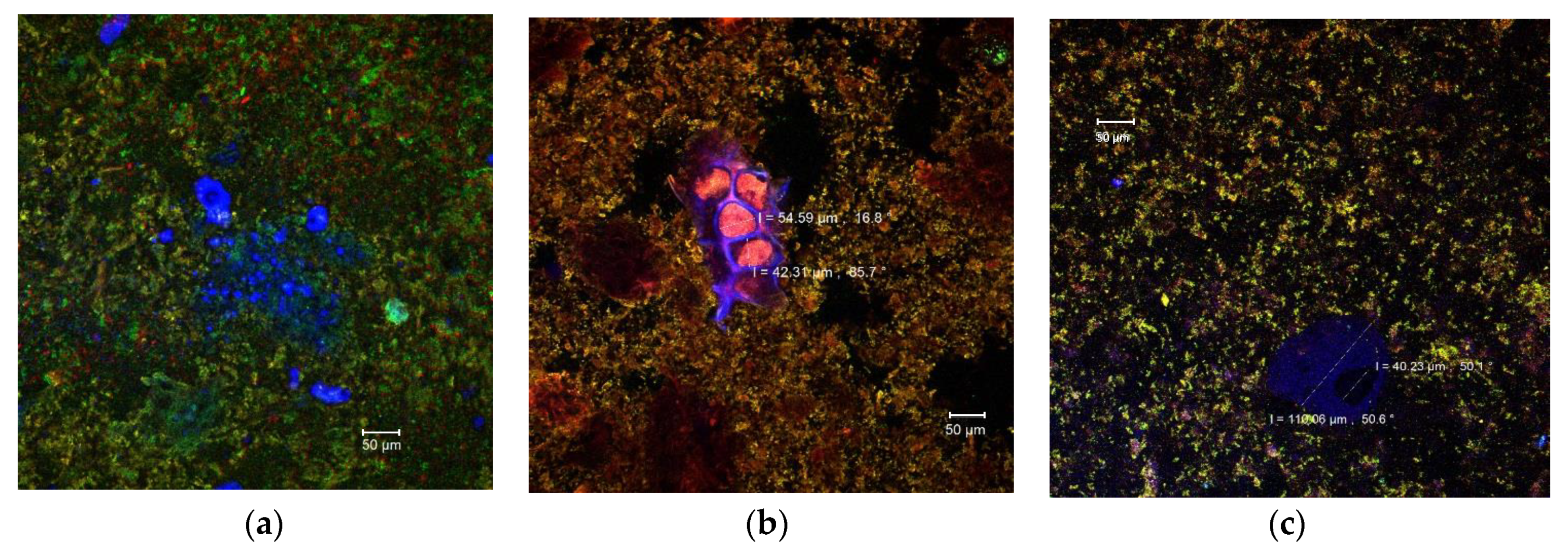
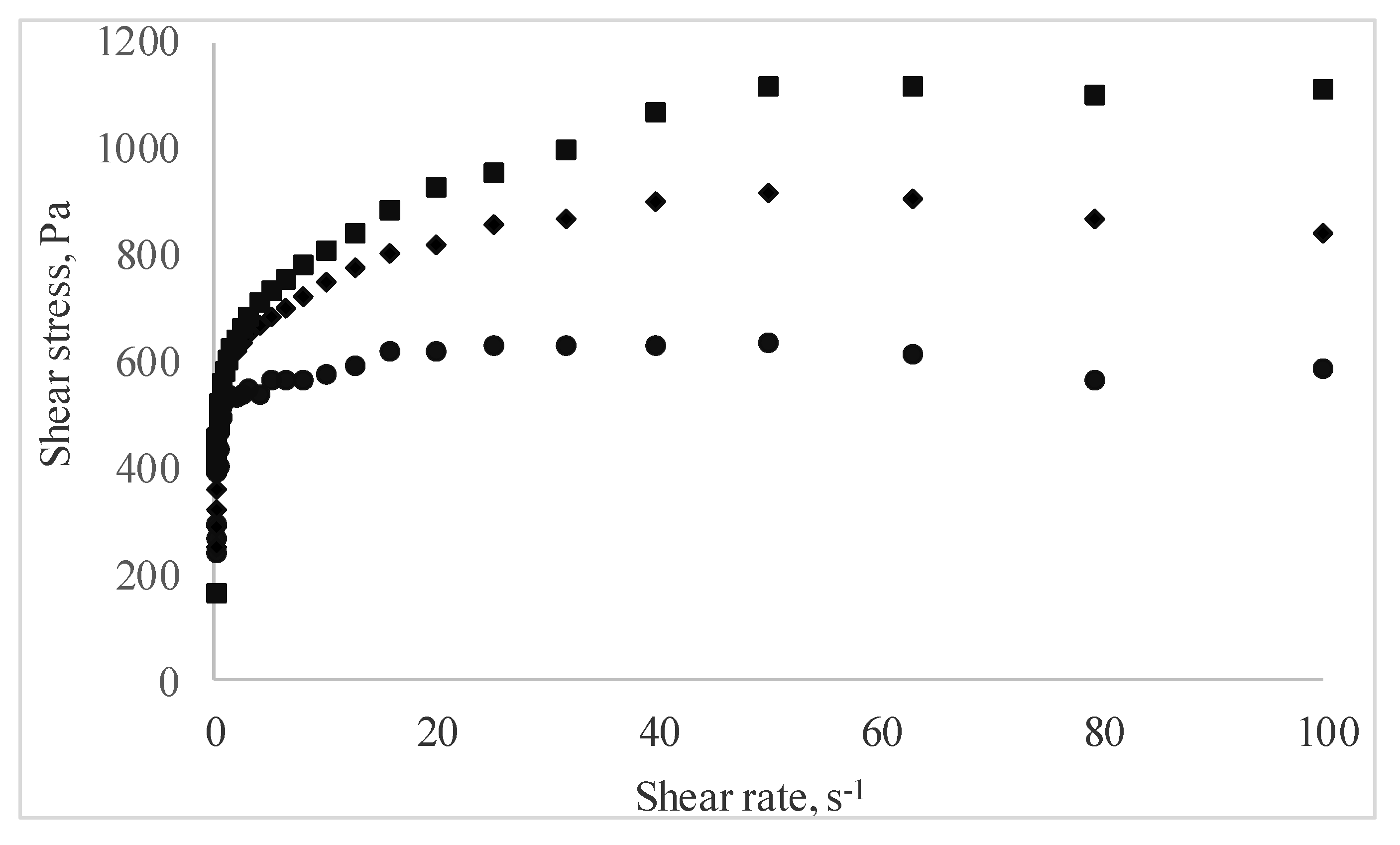
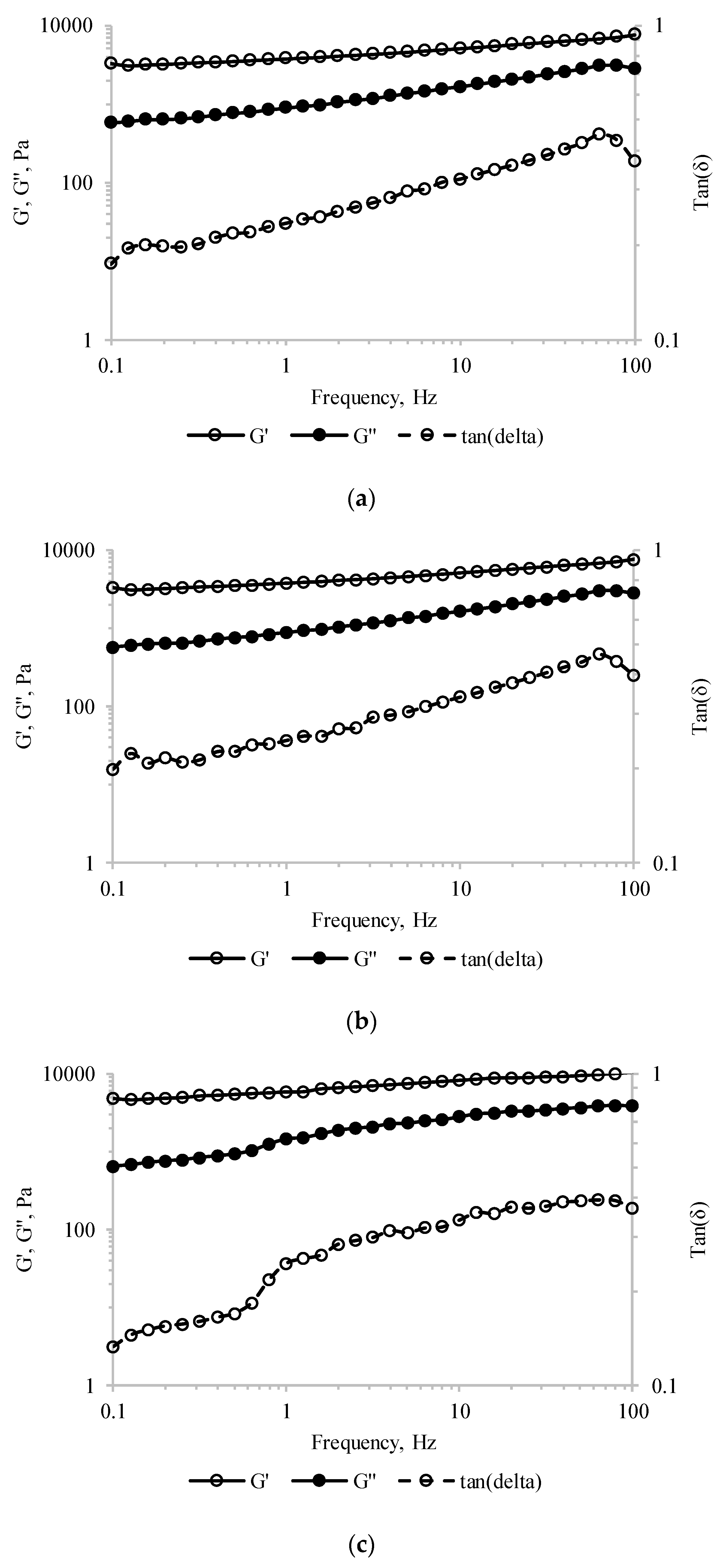
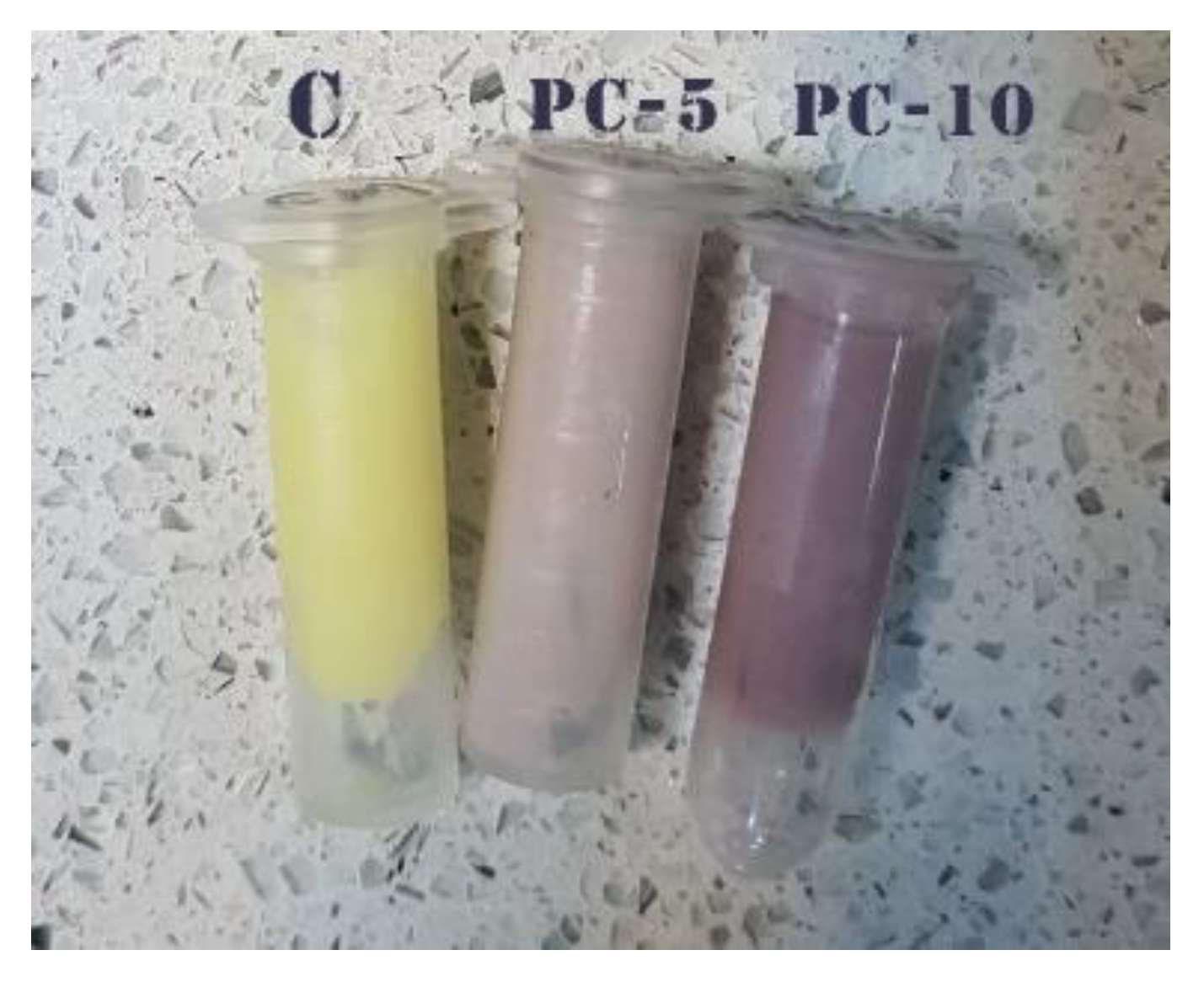
| Sample | Storage Time (hours) | Bioactive Compounds | Antioxidant Activity | ||
|---|---|---|---|---|---|
| TMA (mg D3G/g DW) | TFC (mg CE/g DW) | TPC (mg GAE/g DW) | DPPH (mM/g DW) | ||
| Control | 0 | Nd 1 | 0.334 ± 0.005 a | 0.633 ± 0.027 a | 0.099 ± 0.06 a |
| 24 | nd | 0.282 ± 0.000 b | 0.475 ± 0.068 b | 0.088 ± 0.013 a | |
| 48 | nd | 0.162 ± 0.014 c | 0.373 ± 0.076 b | 0.073 ± 0.011 a | |
| 72 | nd | 0.141 ± 0.018 c | 0.215 ± 0.036 c | 0.065 ± 0.028 a | |
| PC-5 | 0 | 0.125 ± 0.011 a,2 | 0.462 ± 0.009 a | 3.921 ± 0.131 a | 2.282 ± 0.030 a |
| 24 | 0.115 ± 0.007 a,b | 0.462 ± 0.012 a | 3.887 ± 0.076 a | 1.809 ± 0.043 b | |
| 48 | 0.105 ± 0.009 a,b | 0.460 ± 0.020 a | 3.870 ± 0.064 a | 1.777 ± 0.007 b | |
| 72 | 0.100 ± 0.008 b | 0.455 ± 0.015 a | 3.794 ± 0.015 a | 1.765 ± 0.007 b | |
| PC-10 | 0 | 0.255 ± 0.017 a | 0.805 ± 0.019 a | 6.857 ± 0.132 a | 4.814 ± 0.007 a |
| 24 | 0.247 ± 0.007 a | 0.807 ± 0.019 a | 6.769 ± 0.081 a,b | 4.419 ± 0.025 b | |
| 48 | 0.226 ± 0.014 a | 0.801 ± 0.003 a | 6.593 ± 0.147 a,b | 4.407 ± 0.022 b | |
| 72 | 0.222 ± 0.012 a | 0.780 ± 0.020 a | 6.531 ± 0.100 b | 4.401 ± 0.034 b | |
| Textural Parameter | Control | PC-5 | PC-10 |
|---|---|---|---|
| Firmness, N | 7.45 ± 0.25 a,1 | 6.23 ± 0.26 b | 6.25 ± 0.34 b |
| Adhesiveness, mJ | 40.93 ± 2.33 a | 32.67 ± 6.17 a | 36.35 ± 6.80 a |
| Cohesiveness | 0.59 ± 0.03 a | 0.57 ± 0.10 a | 0.62 ± 0.03 a |
| Springiness, mm | 7.86 ± 0.35 a | 7.67 ± 1.12 a | 8.39 ± 0.56 a |
| Chewiness, mJ | 28.93 ± 4.18 a | 28.67 ± 9.29 a | 30.06 ± 2.15 a |
| Rheological Parameter | Control | PC-5 | PC-10 |
|---|---|---|---|
| Flow behavior parameters | |||
| K, Pa·sn | 429.69 | 501.89 | 537.63 |
| n | 0.002 | 0.161 | 0.182 |
| R2 | 0.962 | 0.996 | 0.992 |
| Ƞ50, Pa·s | 8.67 | 18.23 | 22.26 |
| Viscoelastic parameters | |||
| G′, Pa | 3370 | 3767 | 5191 |
| G″, Pa | 830.2 | 882 | 1204 |
| G*, Pa | 3471 | 3869 | 5329 |
| tan δ | 0.2464 | 0.2341 | 0.232 |
| Samples | Color Parameters | ||
|---|---|---|---|
| L* | a* | b* | |
| MBC | 62.69 ± 0.04 | 14.64 ± 0.06 | −0.33 ± 0.02 |
| Control | 80.11 ± 0.08 a1 | −2.71 ± 0.09 c | 24.34 ± 0.01 a |
| PC-5 | 64.74 ± 0.15 b | 12.05 ± 0.03 b | 13.04 ± 0.10 b |
| PC-10 | 58.21 ± 0.08 c | 14.25 ± 0.12 a | 8.82 ± 0.15 c |
| Sample | Sensory Attributes | ||||||
|---|---|---|---|---|---|---|---|
| Appearance | Color | Consistency | Taste | Flavor | Smell | Overall Acceptability | |
| Control | 8.60 ± 0.63 a,1 | 7.33 ± 0.98 c | 8.47 ± 0.74 a | 8.80 ± 0.41 a | 8.87 ± 0.35a | 8.87 ± 0.35 a | 8.07 ± 0.88 a |
| PC-5 | 8.67 ± 0.49 a | 8.33 ± 0.72 b | 8.53 ± 0.64 a | 8.60 ± 0.63 a | 8.87 ± 0.35a | 8.80 ± 0.41 a | 8.53 ± 0.52 a |
| PC-10 | 8.73 ± 0.46 a | 9.00 ± 0.00 a | 8.60 ± 0.63 a | 8.53 ± 0.64 a | 8.87 ± 0.35a | 8.80 ± 0.56 a | 8.47 ± 0.74 a |
© 2020 by the authors. Licensee MDPI, Basel, Switzerland. This article is an open access article distributed under the terms and conditions of the Creative Commons Attribution (CC BY) license (http://creativecommons.org/licenses/by/4.0/).
Share and Cite
Horincar, G.; Enachi, E.; Barbu, V.; Andronoiu, D.G.; Râpeanu, G.; Stănciuc, N.; Aprodu, I. Value-Added Pastry Cream Enriched with Microencapsulated Bioactive Compounds from Eggplant (Solanum melongena L.) Peel. Antioxidants 2020, 9, 351. https://doi.org/10.3390/antiox9040351
Horincar G, Enachi E, Barbu V, Andronoiu DG, Râpeanu G, Stănciuc N, Aprodu I. Value-Added Pastry Cream Enriched with Microencapsulated Bioactive Compounds from Eggplant (Solanum melongena L.) Peel. Antioxidants. 2020; 9(4):351. https://doi.org/10.3390/antiox9040351
Chicago/Turabian StyleHorincar, Georgiana, Elena Enachi, Vasilica Barbu, Doina Georgeta Andronoiu, Gabriela Râpeanu, Nicoleta Stănciuc, and Iuliana Aprodu. 2020. "Value-Added Pastry Cream Enriched with Microencapsulated Bioactive Compounds from Eggplant (Solanum melongena L.) Peel" Antioxidants 9, no. 4: 351. https://doi.org/10.3390/antiox9040351
APA StyleHorincar, G., Enachi, E., Barbu, V., Andronoiu, D. G., Râpeanu, G., Stănciuc, N., & Aprodu, I. (2020). Value-Added Pastry Cream Enriched with Microencapsulated Bioactive Compounds from Eggplant (Solanum melongena L.) Peel. Antioxidants, 9(4), 351. https://doi.org/10.3390/antiox9040351







